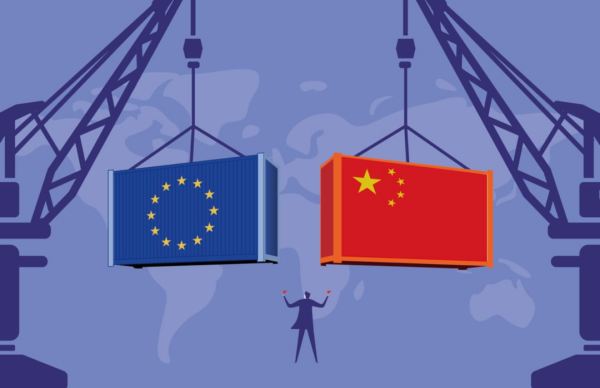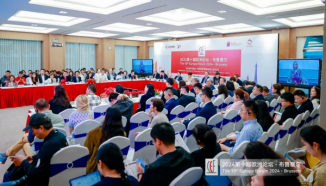The CCCEU Weekly Update Sep 22, 2023: European Chips Act: Catalyst or Mirage?

Editor's Note: Greetings from a drizzly Brussels. As Beijing prepares for the upcoming China-EU high-level economic and trade dialogue, a host of complex issues loom on the horizon. While the EU proudly announced the implementation of its flagship European Chips Act on Thursday, foreign companies are left pondering many unresolved questions. In this edition of the CCCCEU Weekly Update, we delve into the China-EU dynamics. Enjoy your reading and savour a restful weekend.
Weekly updates: Focus
The European Chips Act entered into force on Thursday, putting in place a comprehensive set of measures to ensure the bloc's security of supply, resilience, and technological leadership in semiconductor technologies and applications.
Semiconductors, as the Commission put it, are the essential building blocks of digital and digitised products. From smartphones and cars to critical applications and infrastructures for healthcare, energy, defence, communications, and industrial automation, semiconductors are central to the modern digital economy. They are also at the centre of strong geostrategic interests and the global technological race.
Concretely, the European Chips Act will strengthen manufacturing activities in the Union, stimulate the European design ecosystem, and support scale-up and innovation across the whole value chain. Through the European Chips Act, the European Union aims to reach its target of doubling its current global market share to 20% in 2030.
The Commission outlined the three pillars of the European Chips Act as follows:
The first pillar, the Chips for Europe Initiative, reinforces Europe's technological leadership by facilitating the transfer of knowledge from the lab to the factory, bridging the gap between research and innovation and industrial activities, and promoting the industrialization of innovative technologies by European businesses.
The second pillar of the European Chips Act incentivizes public and private investments in manufacturing facilities for chipmakers and their suppliers.
In its third pillar, the European Chips Act has established a coordination mechanism between the Member States and the Commission for strengthening collaboration with and across Member States, monitoring the supply of semiconductors, estimating demand, anticipating shortages, and, if necessary, triggering the activation of a crisis stage.
"The Chips Act is a unique opportunity for Europe to act jointly across all Member States, to the benefit of the whole of Europe. However, the current chip shortage is a systematic issue with no quick fix," said a statement from the EU's executive arm.
In the short term, the European Semiconductor Board will serve as a coordination mechanism between the Member States and the Commission for mapping and monitoring the Union's semiconductor value chain as well as preventing and responding to semiconductor crises with ad-hoc emergency measures, including information requests, priority-rated orders, and common purchasing.
In the medium term, the Chips Act will strengthen manufacturing activities in the Union and support the scale-up and innovation of the whole value chain, addressing security of supply and a more resilient ecosystem.
And, in the long term, it will maintain Europe's technological leadership while preparing the required technological capabilities that would support the transfer of knowledge from the lab to the factory and position Europe as a technology leader in innovative downstream markets.
Impact Analysis
There remain numerous uncertainties surrounding the potential effectiveness of the European Chips Act in realising its stated objectives.
First and foremost, Europe aspires for the Act to act as a catalyst, gradually resurrecting the EU's semiconductor industry to attain its glory. Against the backdrop of a surging demand for chips driven by the new industrial revolution and digital transformation, Europe seeks to maintain its leading position in key sectors such as automotive semiconductors on the global stage.
Another impetus behind the Act's introduction lies in the strategic moves of the United States and China, both making substantial bets on semiconductor industry development. The United States, through its Chips and Science Act, offers substantial subsidies to bolster the industry, coupled with measures restricting Chinese enterprises, thereby exacerbating fragmentation in the global semiconductor landscape. China, on the other hand, prioritises resolving its semiconductor "bottleneck" and aims for a self-sufficiency rate of 70%.
However, when it comes to crucial investment mobilisation, the EU's current plans may still fall significantly short. The U.S. "Chip and Science Act" encompasses a comprehensive programme with an allocation of approximately $280 billion, including substantial government subsidies of $52.7 billion for semiconductor research and development, manufacturing, and workforce development. Of this, $39 billion is dedicated to semiconductor manufacturing incentives, and an additional $2 billion supports traditional chip utilisation in automotive and defence systems, with a 25% tax break for enterprises establishing chip factories in the United States.
In relative terms, the European "Chip Act" exerts less force, with the EU aiming to allocate a budget of €3.3 billion, alongside member state contributions, in an attempt to draw €43 billion in public and private investments. Consequently, the EU's subsidies are comparatively lower, resulting in reduced appeal for enterprises.
Furthermore, the EU's alignment with the United States in semiconductor policy, coupled with potential restrictions on foreign investments, may intensify competition and access barriers for Chinese enterprises. While the European "Chips Act" signals an intent to attract investments, the EU's tightening business and investment environment in the semiconductor sector may pose challenges. Additionally, the Act's emphasis on supply chain security could lead to the review and control of imported chips, potentially further fragmenting the global semiconductor market and standards.
Weekly updates: Hot Topics
China, the EU to hold high-level economic and trade dialogue in Beijing
The 10th China-EU High-Level Economic and Trade Dialogue will be held in Beijing on Sept. 25, the Chinese Commerce Ministry said on Thursday. Chinese Vice Premier He Lifeng will co-chair the meeting with European Commissioner for Trade Valdis Dombrovskis.
EU envoy decries 'highest deficit in history' ahead of China trade talks
"China's trade surplus with the EU last year was the highest in the history of mankind," Jorge Toledo, the EU's ambassador to China, told a panel discussion in Beijing on Thursday, FT reported.
"Some countries unfortunately for the sake of being politically correct bow to the pressure of a superpower at the cost of the prosperity and stability of Europe," Wu Hongbo, Beijing's special representative on European affairs, told the conference. "It should be up to Europe and European countries to decide what to sell to China. It should not be a decision made by someone else across the Atlantic Ocean."
Michel calls on China to persuade Russia to stop the war
European Council President Charles Michel called on Wednesday on UN Security Council members, particularly China, to convince Russia to stop the war in Ukraine. Michel was speaking at a high-level session of the UN Security Council in New York, chaired by Albanian Prime Minister Edi Rama.
German investments in China increased
German businesses have invested proportionately more in China this year than ever, despite government pledges to reduce dependence on trade with Beijing.
In the first half of 2023, 16.4% of German foreign direct investment (FDI) went to China, a study by the German Institute for Economic Research (IW) reportedly said.
In 2022, only 11.6% of German FDI had been invested in China, which was already more than double the share in 2019, before the pandemic.
Shrinking German business activity points to Q3 contraction
According to Reuters, German business activity fell for the third consecutive month in September due to a sustained decline in demand for goods and services, pointing to a "deep" economic contraction in the quarter, a preliminary survey showed on Friday.
The HCOB German Flash Composite Purchasing Managers' Index (PMI), compiled by S&P Global, rose to 46.2 in September from August's 44.6 but came in below the 47.2 forecasts by economists. The indicator was below the 50 level, pointing to a contraction in business activity.
Commission clears creation of joint venture by Baosteel, Saudi Aramco and PIF
The European Commission on Tuesday approved, under the EU Merger Regulation, the creation of a joint venture by Baoshan Iron & Steel Co., Ltd. ('Baosteel') of China, Saudi Arabian Oil Company ('Saudi Aramco'), and the Public Investment Fund ('PIF'), both of Saudi Arabia.
The Commission concluded that the notified transaction would not raise competition concerns, given that the joint venture has negligible foreseen activities within the territory of the European Economic Area. The notified transaction was examined under the simplified merger review procedure, a statement said.
Weekly updates: What are experts talking about?
China-EU Monetary Cooperation: Dynamics, Challenges, and Paths
Source: Chinese Association for European Studies
Author: Zhao Ke, Zhang Zhe
Currency cooperation is an important part of the comprehensive strategic partnership between China and the EU, and China and the EU have formed a certain foundation for cooperation in such areas as currency swaps, the establishment of an offshore RMB trading market, and the issuance of eurobonds.
The deepening of Sino-European monetary cooperation faces many challenges. The EU's view of China has changed, the restrictions on Chinese enterprises have increased, and the U.S. factor and other factors have brought uncertainty to Sino-European monetary cooperation. Overall, the monetary strategies of China and the EU are still quite compatible, and there is much room for cooperation between the two sides in the future in areas such as green bond issuance, the construction of a global financial safety net, and the development of digital currencies by central banks.
Making the most of Europe's anti-subsidy probe into Chinese electric vehicles
Source: Bruegel
Authors: André Sapir Simone Tagliapietra, Jeromin Zettelmeyer
European Commission president Ursula von der Leyen used her September 13 State of the Union speech to make an important announcement: the launch of an anti-subsidy investigation into electric vehicles coming from China.
The move will split opinions. Some will claim it is high time for the European Union to use its trade policy instruments more proactively to protect its industry against unfair Chinese competition. But the new course will also attract condemnation and claims that the EU is entering a new, dangerous phase of protectionism.
Both of these views have merit. On the one hand, anti-subsidy investigations are not uncommon in the EU (or elsewhere) and fall within multilateral trade rules. On the other hand, this particular investigation is special for two reasons. First, it was not initiated by EU industry but by the Commission, which is a rare situation. Second, it targets not a relatively small industry like optical fibre cables but a multi-billion-euro sector. These factors give this case far greater political profile than normal anti-subsidy investigations announced by the Commission.

 Login
Login Login
Login CCCEU and Gunnercooke Successfully Host Webinar on CSDDD and FLR Compliance to Guide Chinese Businesses
CCCEU and Gunnercooke Successfully Host Webinar on CSDDD and FLR Compliance to Guide Chinese Businesses Cultivating responsible China-EU business leaders essential to tackling global challenges
Cultivating responsible China-EU business leaders essential to tackling global challenges



